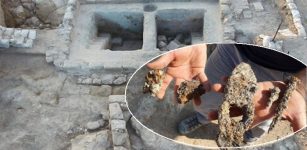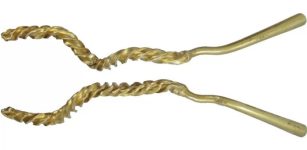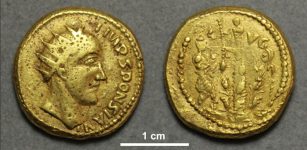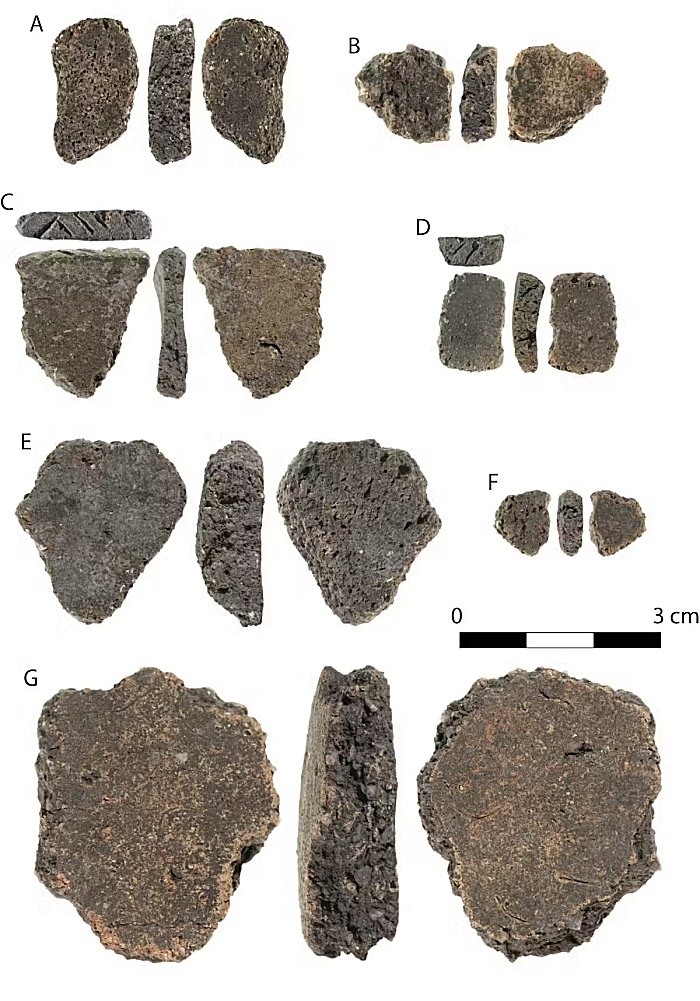Aboriginal People Made Pottery And Navigated To Remote Islands Millennia Before Europeans Arrived
AncientPages.com - Pottery was largely unknown in Australia before the recent past, despite well-known pottery traditions in nearby Papua New Guinea and the islands of the western Pacific. The absence of ancient Indigenous pottery in Australia has long puzzled researchers.
The excavation in progress. Image credit: Sean Ulm
Over the past 400 years, pottery from southeast Asia appeared across northern Australia, associated with the activities of Makassan people from Sulawesi (this activity was mainly trepanging, or collecting sea cucumbers). Older pottery in Australia is only known from the Torres Strait adjacent to the Papua New Guinea coast, where a few dozen pottery fragments have been reported, mostly dating to around 1700 years ago.
Why has no evidence been found of early pottery use by Aboriginal people? Various explanations have been proposed, including suggesting that archaeologists simply weren’t looking hard enough. Well now, we’ve found some.
In new research, we report the oldest securely dated ceramics found in Australia from archaeological excavations on Jiigurru (in the Lizard Island group) on the northern Great Barrier Reef located 600km south of Torres Strait. Our analysis shows the pottery was made locally more than 1800 years ago.
Finding pottery at Jiigurru
Back in 2006, several pieces of pottery were found in Blue Lagoon on Jiigurru, 33km off mainland Cape York Peninsula.
Finding pottery at Jiigurru raised some big questions. How old was it? Was it made by local Aboriginal communities? Or was it traded in from elsewhere? If so, where did it come from? Was it from a European shipwreck? Or was it made by the famous Lapita people who colonised the islands of the southwest Pacific?
Our team excavated several more pieces of pottery from Blue Lagoon in 2009, 2010 and 2012.
Read more: In a first discovery of its kind, researchers have uncovered an ancient Aboriginal archaeological site preserved on the seabed
Preliminary analyses showed most of the pottery was made from local materials. However, despite a lot of work, our efforts to determine the age of this pottery were inconclusive and we were no closer to working out how old it is, or who made it.
In 2013 we went back to Jiigurru to excavate a shell midden on a headland near where the Blue Lagoon pottery was found. A shell midden represents a place where people lived, containing food remains (shells, bones), charcoal from campfires, and stone tools left behind.
Radiocarbon dating showed people started camping at this place some 4,000 years ago, making it the oldest site then known at Jiigurru. But no pottery was found.
A broader search
By 2016 the team had reached a dead end in investigating the few pieces of pottery we had. Instead, working in partnership with Traditional Owners, we turned the research program to the extraordinary Indigenous history of the whole of Jiigurru and began surveying all the islands.
In 2017 we began excavating a large shell midden at Jiigurru located during the surveys.
To our amazement, around 40cm below the surface we began to find pieces of pottery among the shells in the excavation. We knew this was a big deal. We carefully bagged each piece of pottery and mapped where each sherd came from, and kept digging.
The pottery stopped at about 80cm depth, with 82 pieces of pottery in total. Most are very small, with an average length of just 18 millimetres. The pottery assemblage includes rim and neck pieces and some of the pottery is decorated with pigment and incised lines.
Some of the pottery pieces excavated at Jiigurru. Steve Morton
The oldest pottery
But we had another surprise waiting for us.
The deepest cultural material was found nearly two metres below the surface, in levels we radiocarbon dated to around 6,500 years ago. This is the earliest evidence for offshore island use on the northern Great Barrier Reef.
The reef shells eaten and discarded in these lowest levels had been buried so quickly that they still have colour on their surfaces. Archaeological sites of this depth and age are uncommon anywhere around the Australian coast.
Radiocarbon dating of charcoal and shells found close to the pottery shows that it is between 2,950 and 1,815 years old, making it the earliest securely dated pottery ever found in Australia. Analysis of the clays and tempers shows that all of the pottery was likely made on Jiigurru.
We lowered a laser scanner into the completed excavation pit to document the dense collection of shells found in the walls. Ian J McNiven
What does it tell us that we didn’t already know?
The findings are clear evidence that Aboriginal people made and used pottery thousands of years ago.
The archaeological evidence does not point to outsiders bringing pottery directly to Jiigurru. Instead, the evidence shows that Cape York First Nations communities were intimately engaged in ancient maritime networks, connecting them with peoples, knowledges and technologies across the Coral Sea region, including the knowledge of how to make pottery.
Cultural interactions were common around the Coral Sea. Ian J McNiven
They were not isolated or geographically constrained, as once conceived.The results also demonstrate that Aboriginal communities had sophisticated watercraft and navigational skills in using their Sea Country estates more than 6,000 years ago.
What else don’t we know?
The Jiigurru pottery gives us new insight into Australia’s history and the international reach of First Nations communities thousands of years before British invasion in 1788.
Very little research has been conducted anywhere on eastern Cape York Peninsula. We think it is very unlikely that Jiigurru holds the only secrets to our country’s peopled past. What other cultural and historical surprises await to be found?
Provided by The Conversation
This article is republished from The Conversation under a Creative Commons license. Read the original article.
More From Ancient Pages
-
 On This Day In History: Irish Saint Columbanus Founder Of Monasteries In Europe Died – On Nov 21, 615
News | Nov 21, 2016
On This Day In History: Irish Saint Columbanus Founder Of Monasteries In Europe Died – On Nov 21, 615
News | Nov 21, 2016 -
 1,400-Year-Old Iron Hammer And Nails Among Findings At Sanhedrin, Western Galilee’s Usha
Archaeology | Nov 6, 2019
1,400-Year-Old Iron Hammer And Nails Among Findings At Sanhedrin, Western Galilee’s Usha
Archaeology | Nov 6, 2019 -
 Bizarre Mummies And Skeletons That May Offer Evidence Strange Mythical Creatures Did Exist
Featured Stories | Nov 16, 2018
Bizarre Mummies And Skeletons That May Offer Evidence Strange Mythical Creatures Did Exist
Featured Stories | Nov 16, 2018 -
 3,000-Year-Old Twisted Gold Torc Discovered In Essex
Archaeology | Jul 15, 2023
3,000-Year-Old Twisted Gold Torc Discovered In Essex
Archaeology | Jul 15, 2023 -
 Death And Afterlife In Ancient Egyptian Beliefs – Death As Transition To Another Reality
Ancient Traditions And Customs | May 28, 2018
Death And Afterlife In Ancient Egyptian Beliefs – Death As Transition To Another Reality
Ancient Traditions And Customs | May 28, 2018 -
 Dragons And Dragon Kings In Ancient Mythology
Featured Stories | Mar 8, 2023
Dragons And Dragon Kings In Ancient Mythology
Featured Stories | Mar 8, 2023 -
 The Curse Of Chief Chocorua Who Died On The Mountain That Bears His Name
Featured Stories | Mar 9, 2019
The Curse Of Chief Chocorua Who Died On The Mountain That Bears His Name
Featured Stories | Mar 9, 2019 -
 1,000-Year-Old Paintings Unearthed In Sudan – Documented By The Polish Researcher
Archaeology | Sep 25, 2022
1,000-Year-Old Paintings Unearthed In Sudan – Documented By The Polish Researcher
Archaeology | Sep 25, 2022 -
 New Chemical Reactions To Generate Building Blocks Of Proteins And DNA – Discovered
DNA | Jul 29, 2022
New Chemical Reactions To Generate Building Blocks Of Proteins And DNA – Discovered
DNA | Jul 29, 2022 -
 How ‘Listening’ To Archaeological Sites Could Shed Light On The Past
Archaeology | Dec 8, 2023
How ‘Listening’ To Archaeological Sites Could Shed Light On The Past
Archaeology | Dec 8, 2023 -
 Utnapishtim And The Babylonian Flood Story
Featured Stories | Jan 28, 2016
Utnapishtim And The Babylonian Flood Story
Featured Stories | Jan 28, 2016 -
 New Trove Of Treasures, Funerary Temple, 50 Sarcophagi Unearthed In Saqqara, Cairo
Archaeology | Jan 18, 2021
New Trove Of Treasures, Funerary Temple, 50 Sarcophagi Unearthed In Saqqara, Cairo
Archaeology | Jan 18, 2021 -
 Goddess Xi Wangmu (Xiwangmu) Who Controlled Life, Death, Creation And Talked Directly To Humans In Chinese Mythology
Chinese Mythology | Mar 12, 2020
Goddess Xi Wangmu (Xiwangmu) Who Controlled Life, Death, Creation And Talked Directly To Humans In Chinese Mythology
Chinese Mythology | Mar 12, 2020 -
 Mystery Of Moses’ Double Mask, Dramatic Personality Change And The Hidden Prophet – What Did Really Happen On Mount Sinai?
Biblical Mysteries | Jun 25, 2018
Mystery Of Moses’ Double Mask, Dramatic Personality Change And The Hidden Prophet – What Did Really Happen On Mount Sinai?
Biblical Mysteries | Jun 25, 2018 -
 On This Day In History: Astronomer Johannes Kepler Observes Supernova – On Oct 17, 1604
News | Oct 17, 2016
On This Day In History: Astronomer Johannes Kepler Observes Supernova – On Oct 17, 1604
News | Oct 17, 2016 -
 Mystery Of 2000-Year-Old Basel Papyrus Likely Written By Physician Galen – Is Solved
Archaeology | Jul 14, 2018
Mystery Of 2000-Year-Old Basel Papyrus Likely Written By Physician Galen – Is Solved
Archaeology | Jul 14, 2018 -
 Ancient Roman Coins Thought To Be Fakes Are Authentic – Experts Say
Archaeology | Nov 23, 2022
Ancient Roman Coins Thought To Be Fakes Are Authentic – Experts Say
Archaeology | Nov 23, 2022 -
 Neanderthals Invented Or Developed Birch Tar Making Technique Independently From Homo sapiens
Archaeology | May 30, 2023
Neanderthals Invented Or Developed Birch Tar Making Technique Independently From Homo sapiens
Archaeology | May 30, 2023 -
 Evidence Reveals Ancient Saudi Arabia Had A Complex, Thriving Society, Contradicting Notions Of A Struggling Population In Barren Lands
Featured Stories | Aug 21, 2024
Evidence Reveals Ancient Saudi Arabia Had A Complex, Thriving Society, Contradicting Notions Of A Struggling Population In Barren Lands
Featured Stories | Aug 21, 2024 -
 Sacred Number Six And Its Symbolic Significance In Ancient Cultures
Ancient Symbols | Dec 27, 2017
Sacred Number Six And Its Symbolic Significance In Ancient Cultures
Ancient Symbols | Dec 27, 2017




